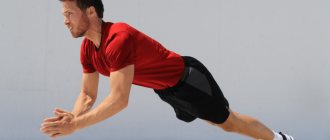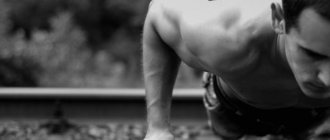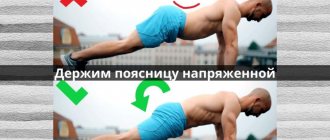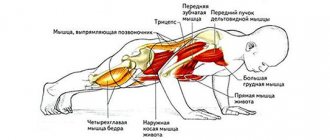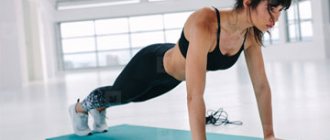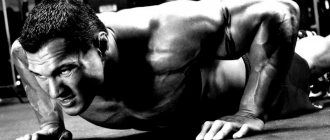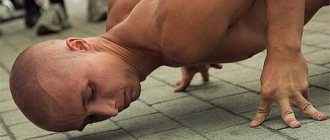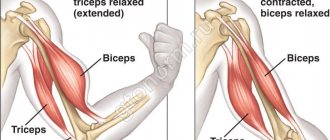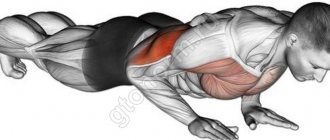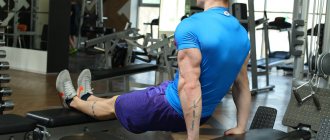Push-ups are one of the most effective bodyweight exercises that develop the shoulder girdle without the use of additional equipment. But what to do if the usual version of the exercise no longer brings visible benefits? It's time to master Indian push-ups or Hindu push-ups, which will allow you to feel the power of exercises with your own weight in a new way, and also develop not only muscles, but also body flexibility.
Benefits of exercise
Indian push-ups, proven over centuries, when performed regularly, will allow you to experience a number of positive effects:
- Strengthening the muscles of the shoulders, arms and chest. Development of muscle strength and endurance.
- Improving spinal flexibility, training the back and core muscles.
- Changing the position of the body from the usual to an inverted one stimulates the functioning of the circulatory system, improves the condition of the vessels of the head and prevents congestion in the pelvis.
- Stretching the pectoral muscles and abs in the second phase of the exercise allows you to increase the work performed by these muscles, and therefore increase the effectiveness of the training.
Contraindications to performing the exercise are high blood pressure, headache, vascular diseases of the head, injuries to the shoulder joints, and in women - menstruation.
Load distribution
In general, the load during the exercise is distributed in a similar way to regular push-ups. The main work is performed by the triceps, pectoralis major muscles and, unlike traditional push-ups, this exercise forces the anterior deltoid muscles to actively work.
Additionally, spinal extensors, abs, and small core muscles are involved. In other words, the load map is quite extensive and you can safely include this exercise in your upper body training program.
What muscles work?
During Indian push-ups, significantly more different muscle groups are involved than with classical push-ups. However, the load on them is distributed more evenly, which somewhat reduces the effectiveness of this exercise as a basic one.
| Muscle group | Load type | Accent |
| Breasts | Main active | Significant |
| Pectoral bundles | Additional active | Small |
| Triceps extensor | Main active | Significant |
| Psoas muscles | Additional active | Small |
| Core muscles | Additional active | Small |
| Abdominal muscles | Main active | Significant |
| Front delts | Main active | Significant |
| Upper deltas | Main active | Significant |
| Rear delts | Additional active | Absent |
| Biceps flexor arm | stabilizing | Absent |
| Forearm muscles | Main active | Significant |
| Psoas muscles | Stabilizing | Absent |
| Trapezoidal | Stabilizing | Absent |
| Quadriceps | Main active | Significant |
| Calf | Main active | Significant |
Execution technique
The exercise can be roughly divided into two phases, when you move forward and go back. Let's look at them in detail.
Starting position: take a lying position, placing your palms slightly wider than your shoulders. Then move your feet closer to your hands so that your pelvis rises up. The pelvis must be raised so that the arms are in line with the body and neck. At the same time, the lower back is slightly arched, the legs remain as straight as possible. If you do yoga, it's simple: get into downward-facing dog pose.
Initial position
- Raise your head so you can look ahead. Bend your elbows and lower your chest almost to the floor, arching your back. Try not to bend your legs. It's like you're ducking under an obstacle. At the same time, the body moves forward.
- Once past the bottom point, push yourself up and forward, fully extending your arms. At the same time, the pelvis goes down, the back is arched as much as possible. Yogis take an upward-facing dog pose, with only their feet resting on their toes.
- Now you need to perform the entire movement in reverse order and return to the starting position. Push your pelvis back and bend your arms. We move our chest above the floor, extend our arms and lift our pelvis.
- Repeat the movement the required number of times.
During the exercise, your chest moves in an arc. The movement is done smoothly without jerking. First you need to do several bends, waves and twists, thus stretching your back and stretching your spine. You can use it on triceps and chest days.
Execution technique.
Execution method
Preparation
- Get on your knees and palms on the floor
- Place your hands shoulder-width apart or most countries in the period
- The knees are placed on the line of the hip joints (below), but the period in countries
- Push-up lift, stretch your legs and straighten your spine
- Your fingers should be at least cm from the position of your hands
- Visiting countries such as the correct position is a little crooked (seats) "L"
Productivity
- Lower shoulders in a straight line to their wrists without twisting the spine. Just before the shoulders touch the wrist begins to move forward with gravity and slip;
- Move your body and elbows forward as you get closer to the wrist, press your body into a push-up position, bringing the weight forward. Unlike push-ups, here the spine curves toward the ground so that you get a nice arc and the head looks forward rather than down;
Straighten Starting position:
Performance Mirror
- In the performance mirror, back the elbows on the wrists and shoulders closer to the floor and in the same way;
- Once your shoulders are aligned with your wrists and your body against the floor (with your legs and spine extended), the push begins to begin the "L" position.
From the burden
- Lift your pelvis up and back without any clasping of your elbows, knees or legs;
Shift the weight of the pelvis and spine already tense before returning to the “L” position.
Benefit
Indian push-ups come from Eastern medicine and are a general strengthening exercise. However, their mechanics can hardly be equated to basic movements. From the point of view of benefits for the athlete, this complex is capable of:
- Significantly increase testosterone production in the body;
- Neutralize the main catabolic processes;
- Strengthen ligaments thanks to a very specific load;
- Replace the main basic complexes in the absence of sports equipment.
Well, the most important advantage of Indian push-ups is their high efficiency. Thanks to the non-standard angle of working the pectoral muscles, you can shock them and overcome a strength plateau, which is important for athletes who have difficulty further increasing their athletic performance. Another important feature of this eastern exercise is the extensive involvement of the spinal muscles. This is especially useful for those who lead a sedentary lifestyle and do not yet strive to go to the gym, but want to prevent osteochondrosis, osteoporosis and other vertebral diseases.
Contraindications and harm
Unlike the axial loads that occur during lower and upper back exercises, Indian push-ups are memorable for their ability to help recover from injury. And most importantly, they do not have any specific contraindications, except:
- The presence of severe muscular dystrophy;
- The presence of a prolapsed hernia;
- Kyphotic curvature of the spine;
- Diseases associated with the gastrointestinal tract;
- Postoperative periods when working with the abdominal muscles;
- Hypertension.
The only harm these push-ups can do is increase the pressure. And then, this is only possible if you seriously disturb your breathing technique during the exercise.
What are the benefits of Indian push-ups?
This exercise is different from other types of push-ups
, actively engages the muscles responsible for changing the position of the spine - the core muscles
(spinal extensors and abs)
, allowing you to increase not only their strength but also flexibility. In addition, due to this change in body position during repetition, Indian push-ups also have a good effect on the vascular system, due to a dynamic change in pressure in it.+
To the question of when and how much to do. I would include Indian push-ups in chest and triceps training after the main exercise in 4-6 sets, the number of repetitions here is individual, in order to add load to the front deltoids and work the core muscles a little. Indian push-ups are also good for exercise, helping to wake up due to the active work of the vascular system.
Recommendations
- Indian push-ups should be performed only after preliminary training of muscles and ligaments with classic push-ups. Untrained muscles and ligaments will not only fail to perform the technique correctly, but will also lead to possible injuries.
- If you have back pain, you should not perform deep bending techniques.
- It is enough to perform 10-20 repetitions of 3-4 approaches, depending on physical fitness.
- For the comprehensive development of the chest and shoulder girdle, it is necessary to combine the exercise with other options for push-ups: from the floor, on a hill, with narrow or wide palms, etc.
- Strength training with weights will also help, increasing the strength and volume of the target muscles. If you perform basic exercises with weights, then push-ups should be performed after.
- Although Hindus develop muscle flexibility and improve stretching, it doesn't hurt to stretch all muscle groups at the end of each workout. This will allow you not only to develop correctly, but also to safely perform exercises, developing technical skills and increasing amplitude.
- Before performing strength exercises, it is important to warm up properly.
Execution technique
Example of execution
Before you begin, warm up well, especially paying attention to the spine. The first thing you need to do to perform Indian push-ups is to take the standard position for most push-ups while lying down, with your hands positioned slightly wider than your shoulders. Then pull your feet towards your palms until your pelvis is raised, as shown in the figure, while your legs and back should not bend. This is the starting position. Start lowering your torso, pushing it forward as if you are overcoming an invisible obstacle. When your hips drop, use your arms to push your torso up. At the end, lower your torso while raising your hips - this is one repetition. If it is difficult to perform this type of push-up, place your hands on a small hill.
Record holders and attempts
- The first push-up record recorded in the Guinness Book of World Records was 6,006 push-ups without stopping by Charles Linster on October 5, 1965.[17]
- The maximum number of push-ups in an hour is 3877, this was done by Bijender Singh (India) on September 20, 1988.[18] The Guinness World Record for most push-ups in an hour is 2806, set by Jarrad Young on August 31, 2022 in Queensland, Australia.[19]
- Doug Pruden (Canada) performed 1,025 one-arm push-ups on the back of the hand on November 8, 2008.[20]
- The flying push-up record was set on March 22, 2013 by Ahmed Valentino Querigo, who achieved a height of 1.36 m (4 ft 6 in).[21][22]
- Paul Lynch (Great Britain) performed 124 push-ups on one finger in a row on April 21, 1992.[23]
- The maximum number of knuckle push-ups in an hour is 2175, done by Syed Taj Muhammad (Pakistan) in March 2016.[24]
- Eva Clarke (Australia), 31 January 2014, achieved the most knuckle push-ups in an hour by a woman - 1206.[25]
- Yuri Tikhonovich (Russia) On April 1, 2010, he did 7 times in a row one-armed push-ups in a headstand.[26][27][28] The record holders are 12 people.[29][30][31]
- The maximum number of push-ups on one finger in 30 seconds was 41, and Xie Guizhong (China) did this on the set of the CCTV-Guinness World Records Special in Beijing, China.[32]
Most push-ups in one minute:
- using the back of the hands: 132 - Abdul Latif Mahmoud Saadiq (Qatar) in November 2009[33]
- with fingertips (10 fingers): 105, Graham Maley (UK), May 2009[34]
- with applause: 90 by Stephen Buttler (UK) in November 2011[35]
- joint: 84 Roy Berger (Canada), June 2016[36]
- one arm using back of hand: 59 by Doug Pruden (Canada), March 2007[37]
- two-finger push-ups (two hands): 52 by Aryan Grover (India) in August 2015.[38]
- Aztec push-ups: 50, performed by Jason Shen (USA) in January 2014.[39]
- two finger push-ups (one hand): 46 - Mohammed Mohamed Ali Zeinkhom (Egypt) in March 2010 (this was in 49 seconds).[40]
- with 100 lb pack: 34 from Paddy Doyle (UK) in June 2011[41]
- one arm carrying a 40-pound backpack: 33 by Hiroyuki Gondo (Japan), May 2014[42]
- Most knuckle push-ups with 40 pounds in one minute: 52, Desh Deepak in January 2022.[43]
What are the benefits of Indian push-ups?
Indian push-ups work the same muscles as regular push-ups: pectoral, triceps and anterior deltoids. Only the anterior deltoid muscle takes on more load; if you want to strengthen its strength, then Indian push-ups are good for you.
This exercise, unlike other types of push-ups, actively involves the muscles responsible for changing the position of the spine - the core muscles (spinal extensors and abs), allowing you to increase not only their strength but also flexibility. In addition, due to this change in body position during repetition, Indian push-ups also have a good effect on the vascular system, due to a dynamic change in pressure in it.
To the question of when and how much to do. I would include Indian push-ups in chest and triceps training after the main exercise in 4-6 sets, the number of repetitions here is individual, in order to add load to the front deltoids and work the core muscles a little. Indian push-ups are also good for exercise, helping to wake up due to the active work of the vascular system.
If you know other effective types of push-ups, share them in the comments.
- Take the position usual for push-ups while lying down.
- Place your arms slightly wider than shoulder-width apart.
- The legs remain straight and the buttocks are raised up, as if arching the back on all fours.
- Bend your arms and lower your body down in a rounded arc.
- When your hips are down, straighten your arms and arch up.
- Your hips should almost touch the floor, your arms straight, and your back arched.
- Return to the starting position by lifting your buttocks up and straightening your arms.
Correspondence
The exercise is suitable for:
- Dynamic stretching - stretch and warm the muscles of the complex
- strength endurance - the muscle undergoes load during movement and thus obtains smooth exhaustion, negative phases of some muscles appear active for others. This caused an active release of synergists. The more serious you are, the more difficult it will be to perform the movements.
- increasing stability and coordination of the trunk muscles. Improves exercise performance: Grani bar/dumbbell bench press/poluleg/leg kickback, dumbbell shoulder press, military press
It is suitable for inclusion in programs with circuit fitness nutrition, as a second nature, or exercise programs for the chest and shoulders.
There are many types
of push-ups
, and all of them are beneficial as they affect our body differently. Today we will talk about Indian push-ups, also known as bomber push-ups or bomber push-ups. Their peculiarity is that the load is emphasized on the anterior deltoid muscles; in addition, the spinal extensor muscles receive secondary load. And so how to do Indian push-ups.
Push-ups (Indian press): description of the exercise
Push-ups are a necessary element of training not only for beginner athletes, but also for professionals. With the help of high-quality push-ups, you can achieve a pumped up torso, abs and, of course, arms. Different types of push-ups will allow you to choose the load of the desired degree of severity.
One of the unusual varieties of push-ups is the “ Indian press
" This exercise is not easy, but it is very effective for developing the muscles of the chest, shoulder girdle, as well as strengthening the legs and back, improving blood circulation and increasing flexibility throughout the body. Pay attention to your breathing when performing this exercise - as you exhale, you assume a lying position, while inhaling, you move forward and bend, the starting position is taken as you exhale, and inhale before the next repetition of the exercise.
Content
- 1 Etymology
- 2 Maintained body weight during push-ups
- 3 Muscles worked 3.1 Abdominals
- 3.2 Deltoid
- 3.3 Chest muscles
- 3.4 Stabilizers: rear housing
- 3.5 Triceps brachii
- 3.6 Forearms
- 3.7 Biceps
- 3.8 Joints and tendons
- 4.1 Weighted push-ups
Hindu or Indian push-ups - strengthening the upper body
The material was prepared by the site team with the support of our experts: athletes, coaches and nutrition specialists. Our team >>
- Reading time: 3 min.
- Benefits of exercise
- Load distribution
- Execution technique
Hindu push-ups, dandas, or as they are also called the Indian press, are a unique exercise that develops not only the strength and endurance of the muscles of the upper body, but also helps improve the flexibility of the spine. It is believed that the movement in its current form was borrowed from the training arsenal of Indian wrestlers. People who are interested in yoga will clearly perceive in it a similarity to the pose of a dog, which first looks down and then up.
Benefits of exercise
Indian push-ups, proven over centuries, when performed regularly, will allow you to experience a number of positive effects:
- Strengthening the muscles of the shoulders, arms and chest. Development of muscle strength and endurance.
- Improving spinal flexibility, training the back and core muscles.
- Changing the position of the body from the usual to an inverted one stimulates the functioning of the circulatory system, improves the condition of the vessels of the head and prevents congestion in the pelvis.
- Stretching the pectoral muscles and abs in the second phase of the exercise allows you to increase the work performed by these muscles, and therefore increase the effectiveness of the training.
Contraindications to performing the exercise are high blood pressure, headache, vascular diseases of the head, injuries to the shoulder joints, and in women - menstruation.
Load distribution
In general, the load during the exercise is distributed in a similar way to regular push-ups. The main work is performed by the triceps, pectoralis major muscles and, unlike traditional push-ups, this exercise forces the anterior deltoid muscles to actively work.
Additionally, spinal extensors, abs, and small core muscles are involved. In other words, the load map is quite extensive and you can safely include this exercise in your upper body training program.
